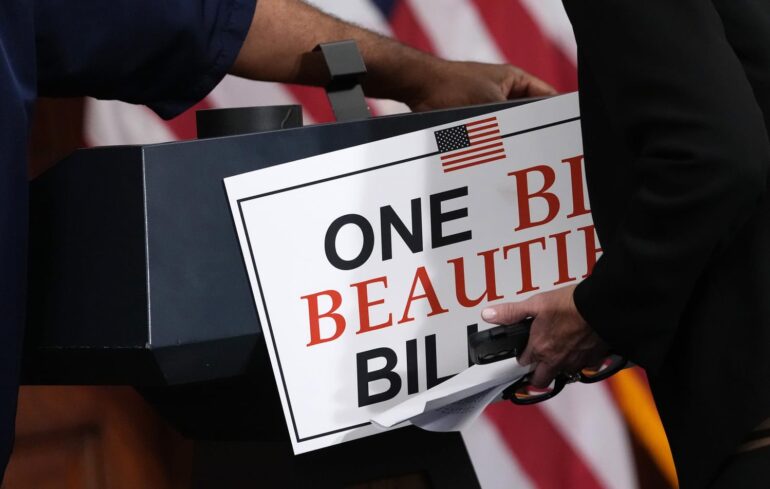On July 1, 2025, Senate Republicans passed President Donald Trump’s massive domestic policy bill, a nearly 1,000-page plan that promises to reshape America’s tax system, healthcare, and social safety net programs. The vote, a tight 51-50 with Vice President JD Vance casting the tiebreaker, marks a significant step toward fulfilling Trump’s campaign promises. However, the bill now faces a tough battle in the House, where divisions among Republicans could jeopardize its passage. Here’s what you need to know about this controversial legislation and what’s at stake.
A Bill Packed with Big Changes
The bill is a bold mix of tax cuts and spending reductions, extending the 2017 tax cuts set to expire this year. It keeps more money in the pockets of families and businesses by preventing tax hikes and introducing new breaks, like no taxes on overtime or tips—key promises from Trump’s 2024 campaign. It also allocates billions for border security, overhauls the federal student loan program, and eliminates the $7,500 electric vehicle tax credit from Biden’s Inflation Reduction Act.
To pay for these changes, the bill slashes funding for programs like Medicaid and the Supplemental Nutrition Assistance Program (SNAP), which supports over 40 million low-income Americans with food assistance. Early estimates suggest the Medicaid cuts could leave around 11 million people—low-income, elderly, or disabled—without coverage. The Senate also added work requirements for Medicaid, targeting parents of older children, and scaled back state provider taxes used to fund the program. To soften the blow, a $50 billion fund was included to support rural hospitals starting in 2026, but some lawmakers, like Maine’s Susan Collins, still opposed the bill, citing its harm to vulnerable communities.
A Delicate Balancing Act in the Senate
Getting the bill through the Senate was no easy task. Republicans used a budget tool called reconciliation to bypass a Democratic filibuster, allowing passage with a simple majority. However, strict Senate rules meant non-budget-related policies were stripped out, frustrating some GOP priorities. Three Republicans—Susan Collins, Thom Tillis, and Rand Paul—voted against the bill. Collins and Tillis worried about the impact on healthcare, while Paul objected to a $5 trillion increase in the nation’s borrowing limit, which he saw as fiscally reckless.
Senate Majority Leader John Thune called the vote a victory, saying it fulfills the “mandate” from the 2024 election to make America “safer, stronger, and more prosperous.” Yet, the bill’s $3.3 trillion addition to the national debt, as estimated by the Congressional Budget Office, has sparked concerns. Critics argue this debt increase could burden younger generations by slowing economic growth and raising borrowing costs.
The House: A Make-or-Break Moment
The bill now heads to the House, where Republicans hold a slim 220-212 majority. House Speaker Mike Johnson faces a daunting challenge to unify his party, as some GOP lawmakers have already signaled opposition. The House passed an earlier version in May, but the Senate’s changes—like deeper Medicaid cuts and a higher $5 trillion debt ceiling (compared to the House’s $4 trillion)—have upset both fiscal conservatives and moderates. The House Freedom Caucus, a hardline conservative group, is pushing for even bigger spending cuts, while representatives like David Valadao from California warn that rural hospitals could collapse without vital funding.
Johnson, under pressure from Trump, has vowed to pass the bill by July 4, emphasizing the “clear mandate” from voters. Trump’s influence has been key, as he’s leaned on holdouts and even targeted dissenters on Truth Social. Still, with such a narrow majority, even a few defections could sink the bill.
Why It Matters
This legislation touches millions of lives. For some, the tax cuts mean more financial freedom, especially for small businesses and workers earning tips or overtime. But for others, cuts to Medicaid and SNAP could mean losing access to healthcare or food assistance. Rural communities, already struggling, face uncertainty despite the new hospital fund. The bill’s environmental impact is also significant, as it rolls back clean energy incentives, potentially slowing progress on climate goals.
The $5 trillion debt ceiling hike avoids a catastrophic default but highlights ongoing tensions over government spending. Fiscal hawks worry about the growing $36.2 trillion national debt, while others argue the investments are necessary to boost the economy.
What’s Next?
The coming days will test the GOP’s ability to stay united. If the House passes the bill without changes, it heads to Trump’s desk for his signature. But if disagreements persist, further negotiations could delay or derail the process. With the July 4 deadline looming, all eyes are on House Speaker Johnson and whether Trump’s influence can push the bill over the finish line.
This bill is more than just policy—it’s a reflection of the nation’s priorities. Will it deliver the prosperity Republicans promise, or will its costs outweigh the benefits? The answer lies in the House’s next move.
